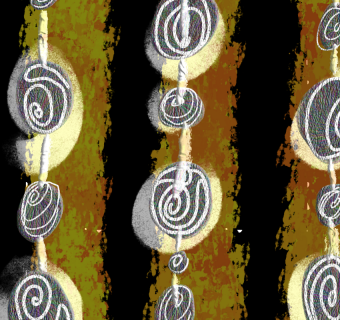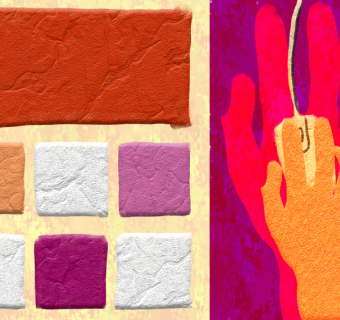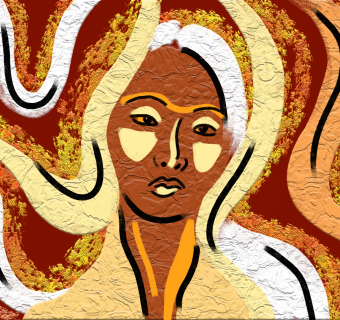The memory of writing my first ever short story is clearly etched in my mind. I remember the setting (an elementary school), the characters (a class of third graders) and the conflict (a radioactive lizard, loose in the classroom). I also remember that all of the characters in that first story, and in my next dozen, were all white.
I have been writing stories for more than a decade, but I have only just begun, slowly, to dare to think of myself as a writer (the title feels elusive, like a low-hanging cloud of smoke that dissipates as soon as I close my hands around it). It took me many years after that first story, after that cast of universally white third graders, to begin producing work that featured people who lived and looked as I did.
I grew up an avid reader. The experience of reading has always harkened back to my first meaningful interactions with books, at four years old. I was a preschooler, chubby-cheeked and decked out in the latest corduroy overalls. I was timid, uncomfortable in English. As is the case for many children born to immigrants, the first several years of my life were defined by a different language. My first day of school was terrifying.
Reading changed everything for me. With a teacher at my side, I made my way through the alphabet and then words and then sentences. In this way, I learned to love school, to love deciphering the mysteries of form and style and character.
I developed a theory: we write not only what we know, but also what we have read.
In elementary school, I read everything. I played sleuth with Nancy Drew, played Quidditch with Harry Potter. I put on plays with the March sisters and bemoaned love affairs orchestrated by ruthless publishers. With Anne Shirley, I longed for puffed sleeves and struggled through geometry. With Jane Eyre, I learned about passion and loneliness and love, and relearned those things over and over. I read books that were too old for me and too young. I read short stories and novels and poems and plays and cereal boxes.
In high school and then in college, I studied stories as a writer. When I had to write a play for an assignment, I pored over Ibsen and Chekhov. For nonfiction, I would turn to Sedaris and Didion. And so on. Books were no longer simply spaces of retreat but also temples and scriptures. I began to draw fine lines between learning texts and enjoyment texts (a line I have since erased, vehemently). I developed a theory: we write not only what we know, but also what we have read.
Read this, I might say, pressing a well-loved book into uncertain hands. It will change you—save you.
As I aged, my canon expanded to include the strange and ancient and delightfully weird. For travel writing, I turned to Mary Wortley Montagu’s Turkish Embassy Letters. For musings on proto-feminism, I turned to another Mary, Wollstonecraft, and her A Vindication of the Rights for Women. As always, I returned over and over to Jane Eyre, but also to Defoe and Austen and Flaubert. I learned to love Shakespeare and to tolerate Homer.
The idea for composing a list of texts by and for South Asian writers first came to me early in college, when I was struggling to balance a premed class schedule (that lasted only a few months) with my stubborn proclivity toward the arts. I lived in a state of perpetual osmosis, refining my creative voice and writing constantly. I sought out Desi authors everywhere I went and amassed an impressive collection, lining my bedroom floor with stacks of books. Among my friends (many of whom are Desi creatives themselves), I became something of a directory. I found myself giving out recommendations with the urgency of a televangelist. Read this, I might say, pressing a well-loved book into uncertain hands. It will change you—save you.
The list, which appears below, is not meant to be comprehensive by any means. I made a deliberate choice, in compiling these few texts, to only feature books that I have read, that have been my teachers and guidebooks in the past. This is a list for writers like myself, writers who wonder where to begin in this vast and varied world of “Desi lit”—once we realize there is such a thing.
I believe there is a reason that some of the best contemporary writing in English comes from people who do not count English as their first language. Books, like our bodies, our countries and our environments, are intrinsically political spaces. They are a reflection of our changing times.
Every one of the below texts is a learning text. Read them and let them teach you (and then go write).
The South Asian Writer’s Handbook(s)
Arundhati Roy, The God of Small Things
The top of my list and of many others. What is there to say about this book that hasn’t already been said? That it won the Booker Prize in ’97? That it catapulted Roy to global superstardom, that it is a modern classic (whatever the hell that means)? That it has, in the past twenty-two years, remained relevant and prescient and gorgeous? All of this can and should be taught to you in any English department worth even a single grain of salt.
Things you might not know: that this novel embodies brilliance on a cellular level. That Roy’s prose is elegiac and alluring and playful in equal measure. That some say the story is centered on twins Estha and Rahel and the ways families process generational trauma. That others insist it is really about “the days when the Love Laws were made. The laws that lay down who should be loved, and how. And how much.” That both are true and not and then true again.
In the two decades since this book was released, Roy has made a name for herself as an advocate for Kashmiri independence, for denuclearization, for Palestine. Hers is the only text on this list that gives serious narrative space to Dalit characters and Dalit issues and confronts the casteism in Indian society without fear of government retribution (see My Seditious Heart for more of Roy’s rebellions). The power of Roy’s voice has transcended literature time and time again, and yet, she remains deeply, rootedly, a writer. Writerly in the best ways.
The God of Small Things is a masterpiece of its time and will likely be a masterpiece in the next. Every time I revisit this book, I learn something new. And that is all that truly needs to be said.
Daniyal Muennuddin, In Other Rooms, Other Wonders
A collection of short stories like no other, In Other Rooms, Other Wonders is an incredible feat, due in part to the musicality of Daniyal Muennuddin’s prose but also because of what it does on a technical level. Each story takes place in the same universe, in the orbit of a singular man—a feudal landowner named K.K. Harouni. Muennuddin captures the tone and texture of this world from the perspectives of K.K.’s driver, his nephew, his mistress. Each chapter is discrete and yet connected to the one that comes after it, revealing something specific about the slices of time and space which these stories span.
In Other Rooms is one of those gorgeous, aggravatingly unfollowed authorial debuts that makes me wish I could tell you about an impending second book. Muennuddin’s skill is breathtaking, with certain images—the henna-dyed soles of a young woman’s feet, the battery-powered television in an old man’s shack—lingering in the mind long after the first (or second, or third read). This, I think, is one of the indicators of prose that is as beautiful as poetry.
In that spirit, I will ask that you read this book and read it again. Sit with its sentences, chew over its words and phrases. Swallow its scenery and taste the dirt and grit of life in feudal Pakistan (the dust being a universal truth in that country). Like poetry, allow it to wash over you and let the language fill your mind. This book is a once-in-a-lifetime text and should be read as such.
Jhumpa Lahiri, Interpreter of Maladies and Unaccustomed Earth
An exception to seemingly every rule, Lahiri is the only author who has two books on this list. Although her entire body of work has much to offer (with both novels being wonderful learning texts in their own rite), there is a specific brilliance to her short story collections that makes them worth a second look, a closer study.
In clean, desperately elegant prose, Lahiri draws fine portraits of Bengali-Indian immigrants (in Interpreter, generally) and their offspring (in Unaccustomed Earth, generally). Although she has rejected the title of “immigrant fiction” which has doggedly pursued her and her work since she won the Pulitzer Prize in 2000, there is something decidedly migratory about the work and about Lahiri herself—the London-born, Rhode Island-bred daughter of Bengali parents. Since 2015, she has written almost exclusively in Italian, choosing in middle age to adopt yet another culture, another linguistic and literary heritage.
My fascination with Lahiri stems not only from her rockstar status, or with her discomfort at being pigeonholed as a “Desi writer,” but also with the way her stories manage to get straight to the heart of my own identity crises. In “When Mr. Pirzada Came to Dine,” from Interpreter, the child narrator notes how her parents think of India as Indians do—as “desh.” But she, the character, thinks of it simply as India. This gulf is the space in which Lahiri operates, and the space in which I read my own childhood. Lahiri is, to be sure, deeply American—I think this shows in her characters’ independence. But I would argue that her Indianness unwittingly rears its head when that independence morphs into isolation. In much the same way, my own writing seems to be oriented about two distinct poles, to be pulled first East, then West, and then back again.
I am obviously partial to Lahiri for reasons that are deeply personal, but I also feel that she is the best example, perhaps in history, of stories that are written for and about brown people without being explicitly about brownness. Although Lahiri’s stories might feature, for instance, a strict parent or a generational divide, these elements are not central—she does not fall into the cheap tropes that so many other Desi creatives (looking at you, Kumail!) have failed to avoid. Instead, the brownness of her characters is almost incidental, unspoken as the whiteness of the characters in the books of my childhood. To me, this is still groundbreaking, as is the rest of Lahiri’s work, almost a canon in and of itself. Read it, read it.
Mohsin Hamid, The Reluctant Fundamentalist
This book is not one of Hamid’s best (for that, turn to Exit West or to Moth Smoke). It is, however a brilliant, trenchant little object—my copy is just over 200 pages, unafraid of empty space. In that liminal field, Hamid considers what it means to fall from grace in the eyes of America. The voice of his narrator, Changez Khan, is the heart and soul of the story, pulling the reader in from the first sentence: “Excuse me, sir, but may I be of assistance?”
On a craft level, Hamid’s skill is magnificent. The narration is in some ways a frame story, allowing us to hear from a distance about Changez’s induction and expulsion from the cult of the American Dream in the months preceding and following the September 11 attacks. Throughout the book, we are incredibly close to Changez, even as he moves back and forth along a fluid timeline. Hamid’s sentences are lean yet lovely, moving the story with an urgency that still manages to linger, the overall effect being delightfully unsettling.
At one point in the novel, Changez speaks of Pakistan as a center of gravity, noting that the country’s pull on him is akin to an “invisible moon at my core.” That feeling is one which will be familiar to any child of diaspora, that sense of deep-seeded connection to homelands we might never have considered home. It is part of why I think Hamid is so crucial for this list.
Read this book to learn about voice, about nonlinear storytelling and what it means to become American. Let it into your mind, its rhythms and staccato beats. Experience it and allow it to make you uncomfortable.
Tanuja Desai Hidier, Born Confused
The only YA novel on this list, and my first foray into this fuzzily-defined subgenre of DesiLit. This book is one which feels rather dated in 2019—the main character is Dimple Lala, a seventeen year old who spends much of the early chapters wishing to be thin and white as her best friend, Gwen. Dimple, the self-pitying daughter of doctors, feels a bit whiny at times, many of her problems painfully adolescent. And yet, this book is also deeply exceptional. Released in 2002, set largely in New York City and New Jersey, it has no mention of the September 11 attacks that were so central to the Reluctant Fundamentalist. The novel considers a specific moment in the American Desi diasporic experience—those odd, mythologized years immediately preceding 9/11. Before we were the othered enemy, we were simply Other, and Hidier grapples with that beautifully.
Born Confused also features the only well-rounded romance between South Asian teenagers I have ever seen in a work of popular culture. Not a South Asian desperately pining for white love interest, but an interconnected, Desi love. It is strange and awkward and beautiful, and I wish there was more of it in YA. The same applies to Hidier’s frank assessment of queerness in Desi communities—it is there, it is considered, it is celebrated.
The title comes from an old acronym: American Born Confused Desi. ABCD. Considered an insult in many South Asian circles, to call someone an ABCD is akin to telling them that they are “whitewashed,” that they have allowed themselves to be physically and psychologically colonized. At the start of the book, Dimple might be considered ABCD, or even worse—she isn’t even familiar with the term. And yet, over the course of this story, which takes her from suburban Springfield to Jackson Heights to NYU bhangra raves, she comes of age in a compelling way that also feels strangely familiar to me.
This is a fantastically weird, witty book with long, interconnected storylines and wordplay galore. The first time I read it, I found myself wishing I had come across it earlier in my life. Perhaps we are all ABCD. Perhaps we are beyond it. Either way, I think that this story is one worth visiting, if for nothing else but the accompanying punk rock booktrack.
Agha Shahid Ali, The Half-Inch Himalayas
Shahid, as he chooses to address himself in his work, displays an early genius in this slim, wrenching volume of poems. Although his later work is more lauded (see: A Country Without a Post Office), I chose this collection because it feels a bit more intimate, a bit unpolished in the poet’s experimentation and intensely personal subject matter.
The collection is divided into four parts. As I see it, the first is dedicated to Ali’s parents and grandparents, the second to his muses, the third to his friends and lovers, and the last to himself. Each section is brief and beautiful and heartbreaking in its own way. The poet poses of himself as a transitory space, turning over his various identities (Muslim, Kashmiri, gay) like imperfect, faceted gems. In precise, metrical lines, he maps out stories that range from the epic to the quotidian.
My favorite poem in the collection closes the third section and is titled simply, “Homage to Faiz Ahmed Faiz.” Ali writes: “blood must not merely follow routine, must not just flow as the veins’ uninterrupted river. Sometimes it must flood the eyes, must surprise them by being as clear as water.”
That is what this collection does to me, as a reader. And what it teaches me, as a writer. Read it, allow it to fill your eyes and veins.
Honorable mentions go to Kamala Shamsie’s Home Fire and Bapsi Sidhwa’s Cracking India. Shamsie, a remarkable writer, warrants credit for her richly drawn consideration of religion and identity in the contemporary West—something notably absent from most of the texts that did make the list. And Sidhwa, a member of Pakistan’s Parsi community, wins points first for her engaging depictions of life in an ethnic minority and secondly for her gorgeous elucidation of the trauma and heartbreak of Partition.
And so—that is all I have to say. I hope this list will help you, teach you, that these texts will shape you as they have shaped me. I wished, as I was putting this list together, that I had access to something like this as a teenager. Consider sharing it with a young Desi creative (or prospective creative!) in your life.
Writing is famously a solitary pursuit. But we, the writers, do not labor in a vacuum. We all take from those who came before us. Someday, we hope, there will be others who will take from us.







